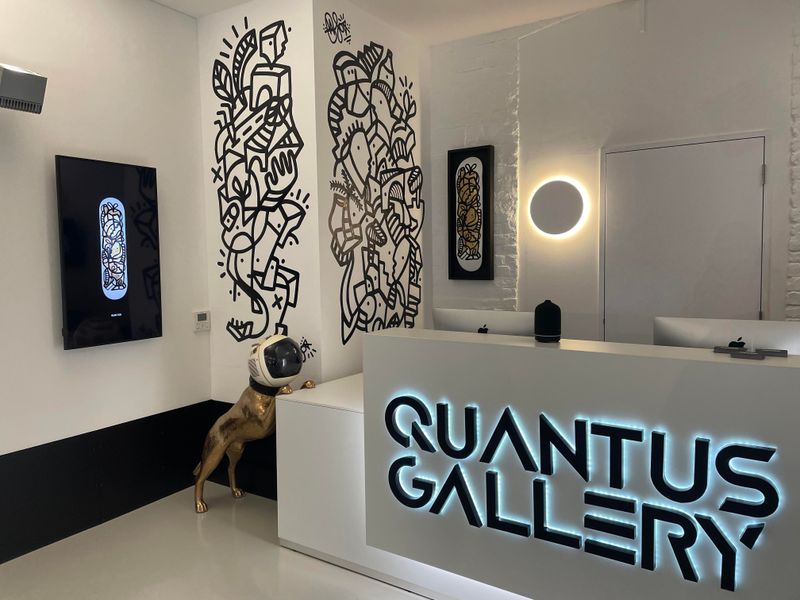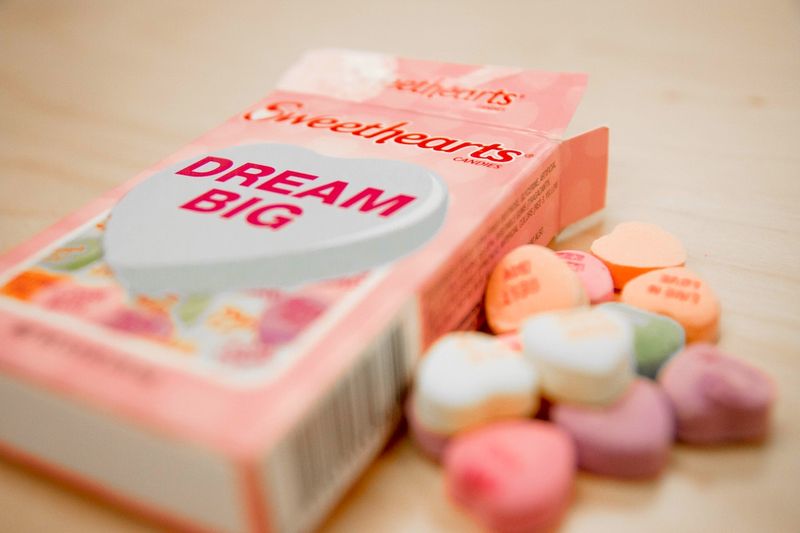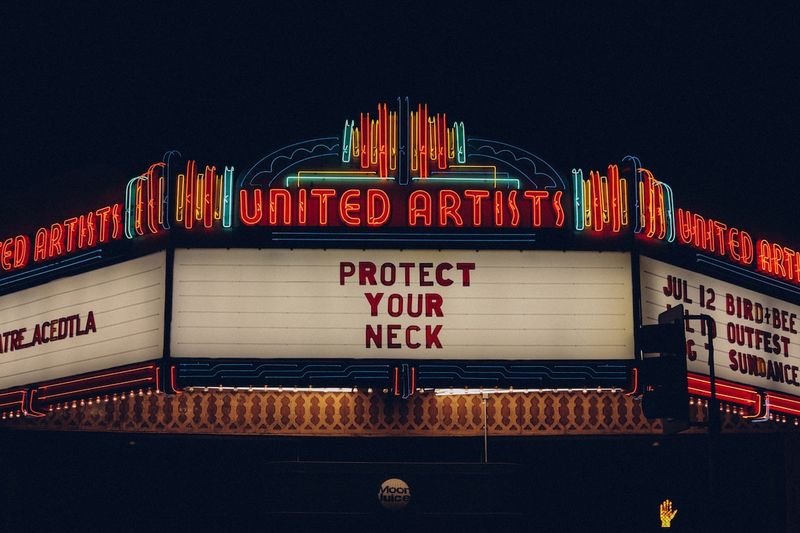It's an interesting concept — traveling to see a physical representation of something that is, by nature, digital.
Quantus Gallery has been open for less than a week. I just had to jump at the chance to see Europe's first NFT gallery. I wasn’t entirely convinced, though. Still, this is a moment in history so I traveled just over an hour expecting to see a screen displaying a jpeg. “Was it even going to be worth it?”, I wondered.
The Preamble
Walking towards the gallery, out of one of London's busiest tube stations, banks turned to expensive coffee shops, which then turned to graffiti-covered walls. The closer I got, the more it felt natural for art to appear.
As I turned into Fashion Street, the home of Quantus Gallery, I was greeted by an empty plot of land covered by a wooden fence. Spray painted on it was our Prime Minister, Boris Johnson, dressed as a clown. Mocking the man who pushed the arts aside once the pandemic hit.
The further I ventured down the street, the art revealed itself more and more — until it was inescapable. I stopped to spend ten minutes exploring the intricate art pieces on the walls, fences, and buildings.
The street had become a canvas for independent artists to strut their stuff. Not for monetary gain, not for internet clout — but for the sake of expression. From grand political statements to silly little doodles — artists could have their say.
It forced me to ask the question of whether art should be owned at all? The walk itself had become a gallery itself, without the need for a concrete owner. Just brick and mortar to act as canvas, accommodation, and curator.
Maybe art isn't for owning but to be experienced? How can someone own a feeling? I don't know, maybe I'm missing the point. Anyways…
Quantus Gallery: Legitimizing NFTs as Art
Stepping into Quantus Gallery, you're hit with a gorgeous smell. I can't quite put my finger on what the smell is. But that smell could alone make the trip worth it.
The atmosphere is closer to a social event than it is a regular gallery. Music is playing, people are standing around chatting, and there are sofas to kick back on. Oh, and of course, that goddamn smell.
The first NFTs I saw were CryptoStars by Pierre Benjamin. The collection brings together 333 historical icons and political figures but as a cartoon. Usually, I'd probably discover this through someone's hexagonal Twitter profile picture or by reading someone’s thread about how this NFT is part of the metaverse.
However, seeing the NFT displayed in this way, somehow legitimized it as a piece of art. Rather than thinking, “why would I want that as my profile picture?!”, I was thinking about the people who were depicted in the art and what they would think of this whole scenario.
What would George Washington think of NFTs? Does digital scarcity fit into his vision for the new world?
What about Shakespeare, what would he think? “Nay! Doth not right-click, saveth”
How would Sigmund Freud psychoanalyze our obsession with NFTs? Are we obsessed with ownership because we had our childhood stolen away from us by technology?
Before I could come to the conclusion of what Pinnochio would think of trading digital assets, one of the receptionists approached me. Dressed just like one of the bankers a few streets back, she asked, "What is your interest in NFTs?"
I didn't think this is the time to give her my Freudian theory about them — so I just told her I'm a journalist here to write a story about the gallery.
"Oh, you're just in luck! One of our co-founders is here.", she said. "Let me go get Ryan." Ryan… now where have I heard the name before? ;)
Soon enough, Ryan Marsh reached over with his hand outstretched, I shook it. Firm handshake. He invited me into what seemed like an office but what also could have also been an art installation — it was filled with Banksy-style street art.
The Argument for An NFT Gallery
"This is an artist called Bluntroller. He's a traditional artist transitioning to NFTs", Ryan explained to me as I looked at the art in the office. "When you buy his NFT, you have the utility of owning the physical art."
This is where I see physical art ownership going. Having cool-looking artwork in your living room is great — really does good things for the room! But when something has a big price tag, an NFT helps you authenticate what you’re buying. Making it easier to trade within the art world and also easier to flex with.
Quantus Gallery signs artists to exclusively sell their art through them, acting as a marketplace as well as a gallery. They are focused on bridging the gap between traditional art collectors and the NFT world.
"People are very wary of scams, especially online", Ryan told me. "A lot of the clients from a traditional background want to come down and see it in person. They can resonate with it a lot better that way — rather than on an online market, the metaverse, etc. They feel a lot more at ease seeing it on the wall."
This is something that technology gremlins, like us, often forget. Older generations can't feel as close to something on their mobile phone or laptop as we can. It helps to see it in a physical way… or as physical as digital art can be.
Even as a digital native myself, I agree. Seeing NFT art up close and personal, on extremely high-quality screens in a gallery environment definitely brought out the art critic in me.
But I couldn't make sense of what ownership actually means in the art world. After all, isn't art an experience rather than property? The waves of introspection that fell over me was an experience I owned. Why do I also need ownership of the art?
It made me think of when 'fake' Banksys were being sold but turned out to be real. Why does art have more value if it is authentic? Surely, the intrinsic value is found within the viewing experience.
Final Thoughts
The fact I'm talking about NFTs as an art form rather than just a profile picture is a testament to the gallery viewing experience. Leaving Quantus, I felt that, for NFT art to be legitimized, more galleries like this should open.
Currently, NFTs are seen as an investment rather than art with emotional value. Even the co-founder, Ryan, said that a lot of their clients are purchasing NFTs as an investment because they feel they've missed out on crypto returns. I understand that but I'm not a whale willing to spend thousands (or millions) on investments like this. This is where fractionalized ownership comes in handy but that's a story for another day.
I'd love to see the NFT gallery viewing experience become mainstream in the art world. I love going to traditional galleries. I enjoy getting lost inside a painting, reading about the artist's history, and coming up with theories about their work. I want this to be the future of digital art and NFTs too.
I can see a future where I travel to Paris and enter the Louvre. I walk down the stairs and through the museum to find the Mona Lisa in all of her glory. Next to it, is a QR code. I scan it and it shows who owns the artwork. Ownership authenticated in a way I can understand and easily interact with.
I’m not sure the Louvre will smell as good as Quantus though…
Check out writer Ryan S. Gladwin's website, follow him on Twitter, and of course, subscribe to the weekly Hedgehog newsletter!






